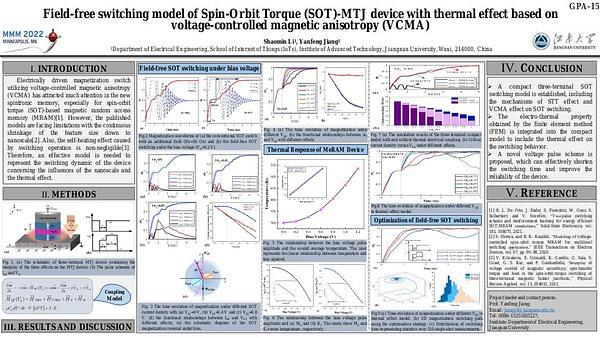Would you like to see your presentation here, made available to a global audience of researchers?
Add your own presentation or have us affordably record your next conference.
Two-dimensional (2D) intrinsic half-metallic ferromagnets (HMFs) are potential candidates for ultrathin spintronic device applications 1. The understanding of
magnetocrystalline anisotropy energy (EMCA) and Gilbert damping (α) is required to determine their use in practical applications. In particular, the thermal stability and critical current of
magnetization switching of spin-transfer-torque magnetic random-access memories highly depend on EMCA and α 2. Therefore, using density functional theory, we study the monolayer
Rhodium dihalides family, RhX2, where X= I, Br, Cl. First, we find that RhX2 prefer 1T phase (octahedral symmetry) than the other possible 1H phase (trigonal prismatic symmetry). The
ferromagnetic ordering is energetically favourable in RhX2 monolayers. The Curie temperature of RhI2, RhBr2 and RhCl2 crystals calculated using spin-wave theory (& Ising model) 3,4
is 182 (304) K, 92 (189) K and 17 (45) K respectively. We then calculate the spin-polarized electronic band structure which reveals wide intrinsic half-metallic gap (> 1.1 eV) in the down
spin bands of RhX2 monolayers. It results in 100% spin-polarization about the Fermi level and should prevent the spin-current leakage in nanoscale devices. The inclusion of spin-orbit
coupling (SOC) does not affect the band’s profile much and the half-metallic character remains intact. Moreover, the metallic nature arises mainly from the hybridization of Rh 4d-orbitals
and X p-orbitals which are present on the Fermi level. The EMCA and α which originate from SOC control the spin dynamics. We use force theorem 5 for EMCA calculation and the
results show substantial in-plane magnetic anisotropy in RhI2(-2.3 mJ/m2) and RhBr2(-0.57 mJ/m2) whereas small perpendicular anisotropy in RhCl2(0.04 mJ/m2) 6. To calculate α we employ Kambersky's torque-torque correlation model 7 and it comes out relatively low (2.1×10-2to 4.0×10-3). This work highlights the importance of 2D RhX2 HMFs in fabrication of future spintronic devices.
References
1 T. Song, X. Cai and M. W. Y. Tu, Science 360, 1214 (2018).
2 S. Ikeda, K. Miura and H. Yamamoto, Nat. Mater. 9, 721 (2010).
3 J. L. Lado and J. Fernández-Rossier, 2D Mater. 4, 035002 (2017).
4 J. M. Dixon, J. A. Tuszynski and E. J. Carpenter, Physica A 349, 487 (2005).
5 D. Li, C. Barreteau, M. R. Castell and F. Silly, Phys. Rev. B 90, 205409 (2014).
6 Ram Krishna Ghosh, Ashna Jose and Geetu Kumari, Phys. Rev. B 103, 054409 (2021).
7 K. Gilmore, Y. U. Idzerda and M. D. Stiles, Phys. Rev. Lett. 99, 027204 (2007).

Fig.1 a) Side view of 1T-RhX2 monolayer and difference between spin charge densities about Rh and I atoms, b) Electronic band structure of RhI2

Fig.2 a) EMCA vs. θ, b) Gilbert damping tensors vs. life-time broadening.
